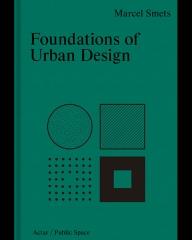The book is structured into twenty-nine essays, each dedicated to a pair of urbanistic concepts. Discussing historical and contemporary, interpretive and designerly approaches to urbanity, the notions composing the 29 pairs relate dialectically, as theses-and-antitheses. Still, we are warned, 'the presented antagonisms are not a priori in opposition, but rather complementary.
'With this book, Marcel Smets not only offers an inspiring vocabulary to describe the spatial features of the city but, above all, a unique dictionnaire raisonné to discuss past and future interventions in our largest man-made artefact.'
Tom Avermaete, Chair for the History and Theory of Urban Design, ETH Zürich.
Smets' fundaments may be likened to emblems. A Renaissance genre, proliferating before the Industrial Age, emblems are complex knowledge repositories, their meaning emerging at the intersection - but not as 'sum' of - a title, a text and an image. The paired titles, the written analysis, alternating abstractions and historic references, together with Heinrich Altenmüller's pairs of essentialized computer graphics, neither completely 'explain', nor exhaust each other's suggestive capacities. Some of the pairs, such as Ribbon - Cluster, Ladder - Star, Fabric - Citadel, wide-span the history of the city, denoting quasi ubiquitous morphologies. Others, such as Monument - Icon, Street - Road, Hole - Void, address (the long) modernity, the second notion illuminating more recent developments. Flow - Shelter, Castle - Palace, tackle the city scale proper, while others, such as Network - Polynuclear Territory, Island - Archipelago, address the scale of the region, characterizing recent planning approaches, such as Landscape Urbanism or Infrastructure Urbanism. Finally, Destination - Morphology, Creator - Curator, Growth - Improvement, question processes and paradigms of making.'
Cristina Purcar, Planning Perspectives, 2021, 36,6,
'Marcel Smets' lexicon of fundamentals offers an operative conceptual framework for urban design, a series of spatial elements, systems and approaches that become a starter tool-kit for the contemporary urbanist. It is an important contribution to the idea of a reflective yet pragmatic form of urbanism that maps the existing urban condition and at the same time rewrites it as a series of spatial figures for a possible or even desired urbanity'.
Els Verbakel, UNESCO Chair in Urban Design and Conservation Studies, BEZALEL Academy of Arts and Design, Jerusalem
'Yet, the most intriguing and fascinating in the structure of this book remains the fact that urban design is not portrayed as a transitory phase in the approach of urbanism, but as the core of the urbanistic discipline as an urban science.'
Ed Taverne, Emeritus Professor, History of Architecture, RU Groningen

(0 Comentarios)